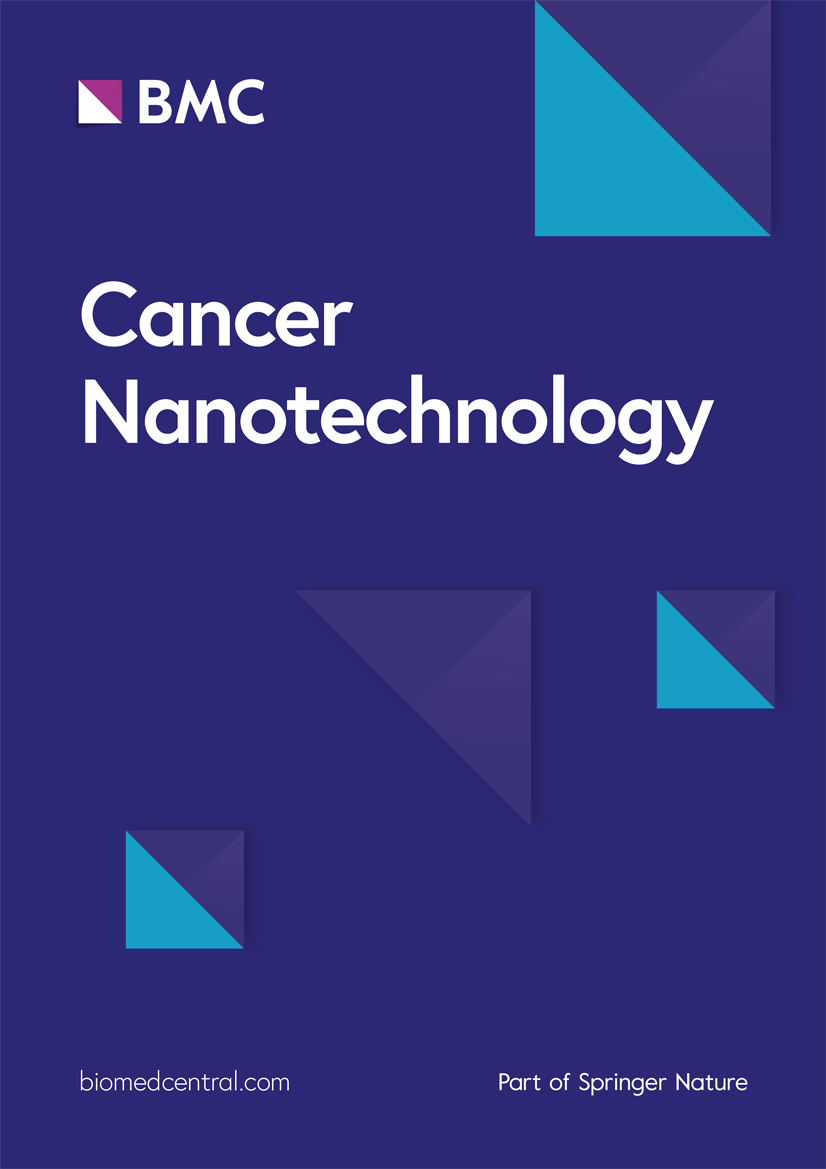High-frequency ultrasound-assisted drug delivery of chia, cress, and flax conjugated hematite iron oxide nanoparticle for sono-photodynamic lung cancer treatment in vitro and in vivo
IF 4.8
2区 工程技术
Q2 NANOSCIENCE & NANOTECHNOLOGY
引用次数: 0
Abstract
Sono-photodynamic therapy (SPDT), which combines photodynamic (PDT) and sonodynamic (SDT) therapies with sensitizers, offers new avenues for cancer treatment. Even though new sensitizers for SPDT have been synthesized with great success, few of them are effectively used. The limited tumor-targeting specificity, inability to transport the sensitizers deeply intratumorally, and the deteriorating tumor microenvironment limit their anti-tumor effectiveness. The current study was carried out aiming at high-frequency ultrasound-assisted drug delivery of chia, cress and flax conjugated hematite iron oxide nanoparticles (CCF–HIONP) for photothermal–photodynamic lung cancer (LCA) treatment in vitro and in vivo as activated cancer treatment up-to-date modality. The study was conducted in vitro on human LCA cells (A-549) and the study protocol application groups in vivo on Swiss albino mice treated with benzo[a]pyrene only and were not received any treatment for inducing LCA, and only after LCA induction the study treatment protocol began, treatment was daily with CCF–HIONP as HIFU–SPDT sensitizer with or without exposure to laser (IRL) or high-frequency ultrasound (HIFU–US) or a combination of laser and/or high-frequency ultrasound for 3 min for 2 weeks. Revealed that HIONP can be employed as effective CCF delivery system that directly targets LCA cells. In addition, CCF–HIONP is a promising HIFU–SPS for HIFU–SPDT and when combined with HIFU–SPDT can be very effective in treatment of LCA–A549 in vitro (cell viability decreased in a dose-dependent basis, the cell cycle progression in G0/G1 was slowed down, and cell death was induced as evidenced by an increase in the population of Pre-G cells, an increase in early and late apoptosis and necrosis, and an increase in autophagic cell death) and benzo[a]pyrene LCA-induce mice in vivo (decreased oxidative stress (MDA), and ameliorated enzymatic and non-enzymatic antioxidants (SOD, GR, GPx, GST, CAT, GSH, and TAC) as well as renal (urea, creatinine) and hepatic (ALT, AST) functions, induced antiproliferative genes (caspase 3,9, p53, Bax, TNFalpha), suppressed antiapoptotic and antiangiogenic genes (Bcl2,VEGF respectively) and effectively reducing the growth of tumors and even leading to cancer cell death. This process could be attributed to photochemical and/or high-frequency sono-chemical activation mechanism HIFU–SPDT. The results indicate that CCF–HIONP has great promise as an innovative, effective delivery system for selective localized treatment of lung cancer that is activated by HIFU–SPDT.高频超声辅助奇异果、芹菜和亚麻共轭赤铁矿氧化铁纳米粒子给药,用于体外和体内声光动力肺癌治疗
声光动力疗法(SPDT)将光动力疗法(PDT)和声光动力疗法(SDT)与敏化剂相结合,为癌症治疗提供了新途径。尽管用于 SPDT 的新型增敏剂已成功合成,但有效使用的却很少。肿瘤靶向特异性有限、敏化剂无法在肿瘤内深层运输以及肿瘤微环境的恶化都限制了它们的抗肿瘤效果。目前的研究旨在通过高频超声辅助给药,将奇异果、芹菜和亚麻共轭赤铁矿氧化铁纳米粒子(CCF-HIONP)用于体外和体内的光热-光动力肺癌(LCA)治疗,并将其作为活化癌症治疗的最新模式。研究在体外对人类 LCA 细胞(A-549)进行,研究方案应用组在体内对瑞士白化小鼠进行,只用苯并[a]芘处理,不接受任何诱导 LCA 的治疗,只有在诱导 LCA 后才开始研究治疗方案、每天使用 CCF-HIONP 作为 HIFU-SPDT 增敏剂,同时照射或不照射激光(IRL)或高频超声(HIFU-US),或同时照射激光和/或高频超声 3 分钟,连续治疗 2 周。结果表明,HIONP可作为直接靶向LCA细胞的有效CCF递送系统。此外,CCF-HIONP 是一种很有前途的 HIFU-SPDT HIFU-SPS,当与 HIFU-SPDT 结合使用时,可在体外非常有效地治疗 LCA-A549(细胞活力的降低呈剂量依赖性,细胞周期在 G0/G1 的进展减慢,细胞死亡被诱导,表现为 Pre-G 细胞数量增加,早期和晚期细胞凋亡和坏死增加、和自噬细胞死亡的增加)和苯并[a]芘 LCA 诱导的小鼠体内(氧化应激(MDA)降低,酶和非酶抗氧化剂(SOD、GR、GPx、GST、CAT、GSH 和 TAC)以及肾(尿素、肌酐)和肝(ALT、AST)功能改善,诱导抗抑郁作用)、AST)功能,诱导抗增殖基因(caspase 3、9、p53、Bax、TNFalpha),抑制抗凋亡基因和抗血管生成基因(分别为 Bcl2、VEGF),有效降低肿瘤的生长,甚至导致癌细胞死亡。这一过程可归因于 HIFU-SPDT 的光化学和/或高频声化学激活机制。研究结果表明,CCF-HIONP 作为一种创新、有效的给药系统,有望用于 HIFU-SPDT 激活的肺癌选择性局部治疗。
本文章由计算机程序翻译,如有差异,请以英文原文为准。
求助全文
约1分钟内获得全文
求助全文
来源期刊

Cancer Nanotechnology
Pharmacology, Toxicology and Pharmaceutics-Pharmaceutical Science
CiteScore
5.20
自引率
1.80%
发文量
37
审稿时长
15 weeks
期刊介绍:
Aim:
Recognizing cancer as a group of diseases caused by nanostructural problems (i.e. with DNA) and also that there are unique benefits to approaches inherently involving nanoscale structures and processes to treat the disease, the journal Cancer Nanotechnology aims to disseminate cutting edge research; to promote emerging trends in the use of nanostructures and the induction of nanoscale processes for the prevention, diagnosis, treatment of cancer; and to cover related ancillary areas.
Scope:
Articles describing original research in the use of nanostructures and the induction of nanoscale processes for the prevention, diagnosis and treatment of cancer (open submission process). Review, editorial and tutorial articles picking up on subthemes of emerging importance where nanostructures and the induction of nanoscale processes are used for the prevention, diagnosis and treatment of cancer.
 求助内容:
求助内容: 应助结果提醒方式:
应助结果提醒方式:


